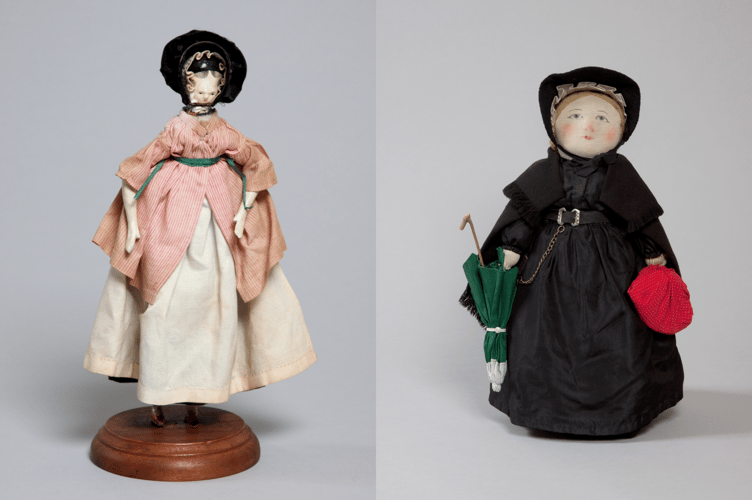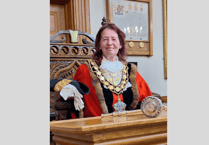This month we’re highlighting the collection of dolls on display in the schoolroom, these include fascinating dolls from the early 19th to early 20th century.
“These dolls bring back memories for many of our older visitors, who often remember similar dolls being handed down from grandparents or earlier generations,” said Collections Assistant Jacquie Morgan.

The earliest doll displayed is a street hawker or pedlar from the early nineteenth century, gifted by Capt J. Rees of Brecon. Pedlars would sell wares in the street or door-to-door. A small doll of simple design, its wooden body is dressed in a brown and black striped skirt, white apron, red and white striped cloak, and a black bonnet.
“The three largest dolls on display in y Gaer all have fascinating backgrounds,” enthused Jacquie.
“The first was called ‘Rosie’ by its owner, Alice Brown, who was a young child when she received it as a prize for her sewing skills in the late 1800s.”
Rosie has a cloth body, wax limbs, blue glass eyes and auburn hair. She is dressed in a child’s knee-length brown silk dress of about 1880 with yellow silk ruffles and light brown lace. She also has a brown straw bonnet with yellow silk ties and bows, a brass chain-link necklace, shoes and socks.
“Under the dress she has two petticoats (white linen and pink flannel), drawers and a chemise,” Jacquie added.
“This elaborate doll was kindly gifted to us by Alice’s family.”
The second is a doll in traditional 19th century Welsh costume. Dating from the late 19th/early 20th century, this doll is wearing a flannel betgwn (dress) of red and black stripes with a black and mustard checked apron, brown shawl, lace under-bonnet, and Welsh hat. She has knitting materials and a partially knitted garment attached to her waist, and an umbrella. In her left hand she is holding an empty basket.
“Her face and hands are made from a kind of porcelain called bisque,” explained Jacquie.
“This is unglazed porcelain with a matte finish, which gives it a realistic skin-like texture. Her eyes open when picked up and close when she is laid down. Few dolls of this age and style are on public display in Wales.”
The third is the most curious doll on display: a Mrs Gamp doll.
“Mrs Gamp was a character in Charles Dickens’ 1843 novel Martin Chuzzlewitt, a midwife who has been immortalised in many media,” said Jacquie.
Dickens described her as “a fat old woman … with a husky voice and a moist eye .. it was difficult to enjoy her society without becoming conscious of a smell of spirits. … [She] went to a lying-in [confinement] or a laying-out with equal zest and relish.”
The doll’s face is very plain, but her accessories are given far more attention, with her umbrella, notebook on chain, and bottle of gin made in far more detail.
Jacquie added: “Throughout the museum we have digital screens/tablet computers containing more information about our exhibits, easily accessed by touching the screen.
To the right of the cabinet containing these dolls, the screen gives visitors the opportunity to find out more about the dolls and other historic childhood items displayed nearby.”
Do any readers have similar dolls handed down the generations? If you have any information to help us add to our knowledge of dolls in our local history, Jacquie would be delighted to hear from you.
Contact us on 01874 624121 or at [email protected] (FAO Jacquie Morgan).





Comments
This article has no comments yet. Be the first to leave a comment.